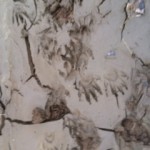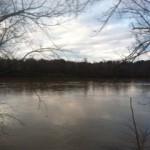After Wednesday’s class trip to the James, I decided that I wanted to visit the river again and see if it was any different after the storm and expected flooding. Even though it was a different section of the river than Belle Isle, it was very apparent that the water was much higher than usual because the steps leading down to the edge of the water were half submerged, and deep, sticky mud extended several feet up the bank, indicating that the water had been even higher not to long ago. I tried to think what could have possibly caused this drastic change, because I couldn’t remember any large rainstorms in the recent past, but I remembered the fact that the river begins on the other side of the state and any activity upstream is carried on downstream. In this case, this fact applies mostly to water and the change in the river’s height, but it also reminded me how any pollution and debris can easily flow downstream as well.
Unlike the small stream that I chose to make my reflection spot, evidence of animal life was abundant at this section of the James. Various types of birds sat in the middle of the river, paddling furiously to remain still as the water surged quickly past them. Unfortunately they were far away, and therefore impossible to identify, but I was able to tell that there were several different types. In addition to the birds, I saw the paw prints of an animal that had recently scurried along the muddy bank, and while I was not sure what had made them, I would hazard a guess that it was a river otter. When I got back to campus, I compared pictures of the prints to pictures of otter tracks I found on the Internet, and they looked nearly identical. I’ve never seen an otter in the wild before, and just seeing the tracks of one was exciting.
The surroundings of the portion of the river that I visited today were drastically different than those near Belle Isle, and while it was impossible to tell based solely on sight, I’m sure these differences also affected the amount of pollution that runs into the James. There were barely any buffer zones to protect the river from urban runoff as the water winds past Belle Isle, but in my section, a fairly thick band of forest surrounded the river on both banks, and thus helped protect the river from any pollutants in the watershed that could possibly run into the river. My earlier realization came back to me however, and I realized that while my section of the river had decent buffer zones, any urban environments with no buffers upstream of where I was standing could still harm the river. This isn’t to say that the buffers at my section of James were useless, because they still help prevent erosion and offer habitat to wildlife, but their usefulness is unfortunately diminished by the connected nature of the river.





